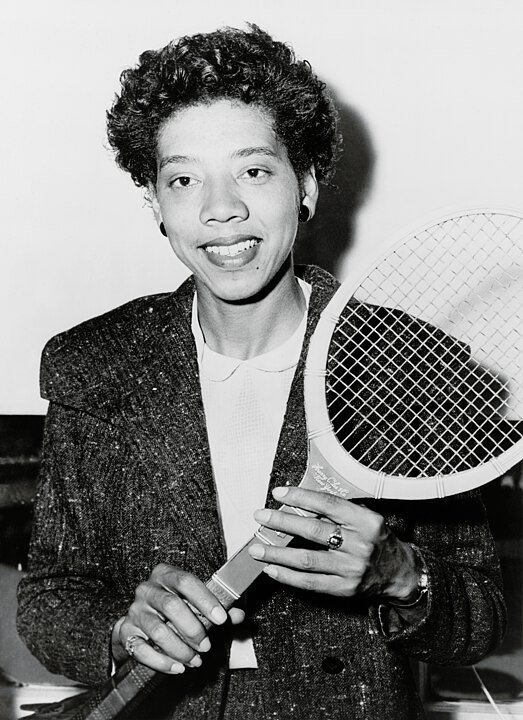Althea Gibson’s journey from the cotton fields of South Carolina to the hallowed lawns of Wimbledon is a story of resilience, determination, and triumph. As the first African American to win a Grand Slam title, Gibson shattered racial barriers in tennis and inspired generations to come. Her life was a testament to perseverance, as she overcame poverty, segregation, and systemic discrimination to become one of the greatest athletes of her time.
Althea Gibson’s Early Beginnings: The Foundation of a Champion
Althea Gibson was born on August 25, 1927, in Silver, South Carolina, to sharecropper parents. Her family moved to Harlem during the Great Depression, seeking better opportunities. Growing up in a cramped apartment on 143rd Street, Gibson found solace in sports. She was a natural athlete, excelling in basketball, paddle tennis, and even street fighting. “I played with any kid on the block,” she later recalled. “It didn’t matter whether they were white, brown, black, or yellow”.
Her introduction to tennis came through Buddy Walker, a musician and Police Athletic League supervisor who noticed her talent and gifted her a tennis racket. By 12, Gibson had won the New York City women’s paddle tennis championship. Her raw power and athleticism caught the attention of Fred Johnson, a one-armed tennis pro at Harlem’s Cosmopolitan Tennis Club, who became her first coach. Under his guidance, Gibson began competing in the American Tennis Association (ATA), the only organization that allowed African Americans to play.
Overcoming Adversity: Althea Gibson’s Battle with Racism and Poverty
Gibson’s path to greatness was fraught with obstacles. Despite her dominance in the ATA, she was barred from competing in major tournaments due to her race. In 1950, former tennis champion Alice Marble wrote a scathing editorial in American Lawn Tennis Magazine, demanding that Gibson be allowed to compete. “If Althea Gibson represents a challenge to the present crop of women players, it’s only fair that they should meet that challenge on the courts,” Marble wrote.
Gibson’s first appearance at the U.S. Nationals in 1950 was a watershed moment. She faced reigning Wimbledon champion Louise Brough in a rain-delayed match that captivated spectators. Though she lost, her performance proved she belonged among the elite. Yet, even as she rose through the ranks, Gibson faced relentless discrimination. She was denied entry to hotels, excluded from social events, and subjected to racial slurs from spectators.
Althea Gibson’s Pivotal Moments: From Challenge to Victory
Gibson’s breakthrough came in 1956 when she won the French Open, becoming the first African American to win a Grand Slam title. She defeated Angela Mortimer in the final with a score of 6–0, 12–10, showcasing her dominance on the clay courts of Roland Garros.
The following year, she made history again by winning Wimbledon and the U.S. Nationals. At Wimbledon, she received the winner’s trophy from Queen Elizabeth II, a moment she described as “a long way from being forced to sit in the colored section of the bus”. Her victories were not just personal triumphs but also symbolic victories for the African American community. Gibson’s success challenged the entrenched racism of the tennis world and paved the way for future champions like Arthur Ashe and the Williams sisters. “She opened doors for us,” Venus Williams once said. “Her accomplishments set the stage for my success”.
Althea Gibson’s Legacy: Inspiring Change Through Perseverance
Gibson’s impact extended beyond the tennis court. After retiring from tennis, she became the first African American woman to join the Ladies Professional Golf Association (LPGA). Though she faced similar barriers in golf, her presence helped break down racial barriers in another elite sport.
In her later years, Gibson struggled financially and with health issues, but her legacy endured. In 2019, the U.S. Tennis Association unveiled a statue of her at the Billie Jean King National Tennis Center, honoring her contributions to the sport. “It’s about time,” said Angela Buxton, her former doubles partner. “Althea did a great deal to improve the place of Black people”.
Conclusion
Althea Gibson’s story is one of courage, resilience, and unyielding determination. She overcame racial and economic barriers to become a trailblazer in tennis and golf, inspiring countless others to follow in her footsteps. Her legacy reminds us that greatness is not just about winning titles but about breaking barriers and creating opportunities for others.
As we celebrate her achievements, let us also remember her words: “I always wanted to be somebody. If I made it, it’s half because I was game enough to take a lot of punishment along the way and half because there were a lot of people who cared enough to help me”.
Discover More Inspiring Stories of Barrier-Breaking Athletes
Althea Gibson’s legacy of perseverance and breaking barriers continues to inspire athletes across all sports. Dive deeper into stories of resilience with Simone Manuel, the first African American woman to win an individual Olympic gold medal in swimming, who shattered stereotypes and paved the way for diversity in aquatic sports. Or explore the incredible journey of Sister Madonna Buder, the “Iron Nun,” who proved that age is no limit by competing in Ironman triathlons well into her 80s. These athletes, like Gibson, remind us that determination and courage can overcome any obstacle. Read more about Simone Manuel and Sister Madonna Buder to be inspired by their extraordinary achievements.
Photo by: De Adam Cuerden – via Commons: https://commons.wikimedia.org/w/index.php?curid=1305609




